Florida citrus growers face the possibility of producing the smallest crop since the Great Depression, which might be overly optimistic for an industry ravaged by Hurricane Ian as the new season gets underway.
The U.S. Department of Agriculture on Wednesday released an initial forecast for the 2022-2023 growing season that showed overall citrus production down a projected 31.8 percent from the past season. That would result in the lowest production since the 1935-1936 season, based on Florida Department of Agriculture and Consumer Services statistics.
Mark Hudson, U.S. Department of Agriculture state statistician, said the numbers released Wednesday were based on surveys of citrus groves before Hurricane Ian tore through citrus-growing areas of Southwest Florida. The industry has struggled for years with issues such as deadly citrus-greening disease, and the surveys found trees showing smaller-sized fruit and fewer oranges per tree.
“We finished up on measurements about the 23rd or 24th of September,” Hudson said.
In the news: Florida Players Have A Chance At $914 Million In Jackpots
The Category 4 storm made landfall Sept. 28 in Lee and Charlotte counties before crossing the state. Hudson said there wasn’t time to return to the groves for a post-storm update of the conditions.
A December forecast will reflect updated inspections of groves, Hudson said.
The industry during the 2021-2022 season had its lowest output in eight decades. Along with citrus greening, growers also face increased demand for land in the rapidly developing state, higher labor costs and foreign competition.
Before the forecast was released Wednesday, U.S. Sen. Marco Rubio, R-Fla., submitted what he called an “initial” major-disaster spending request of $33 billion to help rebuild after Ian, including $2.955 billion to address effects on the agriculture industry.
The forecast projects that citrus growers will produce 28 million 90-pound boxes of oranges and 2 million boxes of grapefruit during the 2022-2023 season. The industry uses 90-pound boxes as a benchmark.
During the 2021-2022 season, growers produced 41.05 million boxes of oranges and 3.3 million boxes of grapefruit. The outputs were the lowest since the 1942-1943 season for oranges and the 1917-1918 season for grapefruit.
Specialty fruits, primarily tangerines and tangelos, are expected to fill another 700,000 boxes during the 2022-2023 season, down 50,000 from the past season.
The new forecast would represent the smallest orange crop since 24.9 million boxes were filled in the 1931-1932 season.
In the news: Mexican Drug Cartel Members Among 25 Charged In Florida, 50 Pounds Of Fentanyl Seized
Two decades ago, Florida growers produced enough oranges to fill more than 200 million boxes a year, with grapefruit production around 50 million boxes.
Last season, growers in Polk County accounted for the most citrus, filling 7.77 million boxes. DeSoto County was next at 6.8 million boxes. Highlands County growers filled 6.65 million boxes, and Hendry County was at 5.5 million boxes.
DeSoto, Hendry and Polk were among the hardest-hit rural counties in Ian.
When Hurricane Irma plowed through citrus-growing regions at the start of the 2017-2018 season, production fell 37 percent from the prior season.
Senate Appropriations Chairwoman Kelli Stargel, a Lakeland Republican who faces term limits this year, said Wednesday state leaders will need to continue supporting the industry.
“I personally do not want to see all these agriculture communities and orange groves turn into housing sprouts,” Stargel said. “I know we have a housing issue as well. … I’m termed out. But I’m confident our future House and Senate and future agriculture commissioner and others will be looking at these issues very seriously, on how we can support agriculture and making sure we have food that is locally grown within our country and our state.”
The state Department of Agriculture and Consumer Services estimated Hurricane Irma inflicted $2.5 billion in agriculture losses on Florida, with $761 million hitting the citrus industry.
A preliminary damage estimate for Ian has not been released.
Agriculture Commissioner Nikki Fried issued a statement Wednesday that said her department “remains committed to innovation in the face of the ongoing challenges of weather events like Ian, citrus greening and unfair trade practices.”
“It is heartbreaking to see such an iconic Florida industry hurting right now,” Fried said. “This year will be tough, no one is disputing that, but I believe in the tenacity and passion of our citrus industry professionals to come back stronger than ever.”
The state budget that went into effect July 1 included $37 million for the citrus industry, with the biggest chunks of money being $17 million for Department of Citrus marketing programs, $8 million for research programs, and $6.2 million for what is known as the Citrus Health Response Program, which includes cultivating new trees resistant to greening.
Visit Tampafp.com for Politics, Sports, and National Headlines. Support journalism by clicking here to our GiveSendGo or sign up for our free newsletter by clicking here.
Android Users, Click Here To Download The Free Press App And Never Miss A Story. Follow Us On Facebook Here Or Twitter Here.
Copyright 2022 The Free Press, LLC, tampafp.com. All rights reserved. This material may not be published, broadcast, rewritten, or redistributed.

